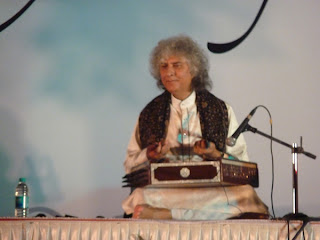 |
| Outdoor Concert at dawn, St. Xavier's College, January 26th |
Flew from Kolkata with Steve Gorn. We then took the taxi to Dadar, left our bags at (tabla player) Prafulla Athalye’s place and walked up the road to the Dadar Matunga Cultural Centre to see Ulhas Kashalkar perform. Steve and I both think he is the finest male vocalist performing today. And he had his “A-team” of accompanists: Suresh Talwalkar on tabla (he has more sheer fun performing than any other player I can think of) and Sudhir Nayak on harmonium (incredibly virtuosic playing, but done in a way that never distracts from the vocal). Since my program was at the same venue the next morning, part of the same Pandit Bhatkande Memorial Festival, I wanted to meet the principal secretary/organizer of the Centre, Pandit Sharad Sathe, as well as see the hall.
After the program Steve and I collected our things and headed south to the Colaba area to the YWCA (yes) where (we thought) we had a room reserved. Instead we got that indescribable sensation of walking up to the desk rather late in the evening, announcing ourselves and having the staff look at us blankly, “who are you?” It turned out that the reservation officer had been answering our emails but not writing the reservation in their book. The Y is still one of those places, very typical in India from days past, where everything (and I mean everything) is recorded in ledgers and journals in long hand. (I still remember banks in Calcutta that I went to in 1979 that had giant ledgers stacked floor to ceiling at the back of the room.) So in an interesting confluence of old and modern technologies Steve and I both pulled out our MacBooks and showed them the emails we had received. They found me a single room so small that I had to leave my sarode case standing upright, and poor Steve had to sleep in one of the offices for the night, but they got us sorted out and I had a great single room there for the next two weeks.
My first program in Mumbai was the next morning (January 23rd), back at the Dadar Matunga Cultural Centre, with Prafulla Athalye (one of Alla Rakha Khansahib’s senior students) on tabla. Bilaskhani Todi and Misra Kafi. Later that afternoon I made it to the NCPA in time to catch the last session of the yearly seminar on music organized by Pandit Arvind Parikh; not so much for the content of the conference truth be told but to pay my respects to Arvind-ji, who has done more than anyone in the last 20 years to keep the Hindustani classical music scene alive in Mumbai. An amazing man, really, now in his 80s, head of maybe the largest transportation and international communications company in India, a very wealthy man, and dedicated to Indian music as a musician, a senior disciple of Ustad Vilayat Khan, and as a patron. Then off to drink beer and eat Mangalore-style seafood with the Dutch contingent (Joep Bor, Wim van der Meer and Frances de Ruiter), Richard Widdess from SOAS, Steve and Jon Barlow. Many thanks again to Professor de Ruiter and the International Musicological Society for picking up the tab at the end of the evening!
Most of the next week was spent practicing and checking out a succession of local restaurants in the Colaba area, from INR 1,000+ fancy places like Indigo to the South Indian veg place a few steps away where a great masala dosa cost about INR 60 (a rupee is currently worth about 2¢). Very happy to make a few trips to Bademiya, the wonderful outdoor kebab place that sets up on a back street behind the Taj hotel every night and runs until about 1:00 am. I used to see or be taken to this barbecue on my first trips to Mumbai, and then not be able to find it again, or I would find it walking around late one night and then lose track again. Now I finally know, so I can always get one of their famous seekh kababs when I want. I took Ty Burhoe, on his first trip to India, figuring that this was an iconic Mumbai destination.

January 26th morning, Republic Day, featured a dawn program in the courtyard of St. Xavier’s College by Pandit Shivkumar Sharma, santoor, accompanied on tabla by Yogesh Samsi and Bhawani Shankar on packawaj. It was quite magical and definitely worth getting up at 5:30 for. I finally got to meet up with Ty, and well as meet Takehiro, Shivji’s student from Japan, and Max, another student from Brooklyn. After the program Yogesh invited Ty and I to his wonderful family home in Gamdevi, one of the older sections of Mumbai, for breakfast. Toast with homemade butter still stands out as one of the outstanding food experiences I had on this trip.


















